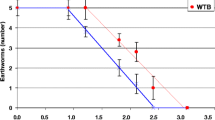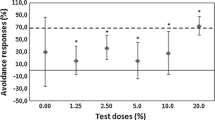Abstract
In lowland areas of the Netherlands, any peat sediments will gradually become enriched with anthropogenically derived Polycyclic Aromatic Hydrocarbons. Due to Dutch policy standards these (anaerobic) sediments are not allowed to be dredged and placed onto land. Under aerobic conditions, however, biodegradation of PAH is greatly enhanced. This degradation is further stimulated by colonisation of the sediments by earthworms. Laboratory experiments show that although earthworms do not avoid PAH-contaminated sediment, their burrowing-activity is reduced. Furthermore, these sediments have no significant ecotoxicological impacts on earthworms. Experimental introduction of earthworms into PAH-contaminated OECD-soil will result in a decrease in overall PAH content. In field surveys no significant differences in earthworm numbers between locations with fresh and old sediment could be found. It is concluded that dredging of PAH-contaminated sediment poses a very limited environmental threat, and that putting these sediments on land will improve PAH-biodegradation, partly through the colonisation by and activities of earthworms.
Similar content being viewed by others
References
Edwards, C.A. (ed) (1998). Earthworm Ecology. Boca Raton, FL: St. Lucie Press.
Eijsackers, H. and Doelman, P. (2000). Using natural cleaning processes in the river ecosystem: a new approach to environmental river management. Does natural attenuation outbalance the risks of organic and inorganic contaminants in a river ecosystem?, In A.J.M. Smits, P.H. Nienhuis, and R.S.E.W. Leuven eds New Approaches to Riυer Management. Leiden, The Netherlands: Backhuys.
Huiting, A.M., Kramer, P.R.G. and Beurskens, J.E.M. (1997). Prognose van de PAK-gehalten in de landbodem onder invloed van het verspreiden van baggerspecie. Report 733 007 002. Bilthoven, The Netherlands: National Institute for Public Health and the Environment (in Dutch with English summary).
Hund, K. and Traunsperger, W. (1994). Ecotox-evaluation strategy for soil bioremediation exemplified for a PAHcontaminated site. Chemosphere 29, 371–90.
Kalf, D.F., Crommentuijn, T. and van der Plassche, E. (1997). Environmental quality objectives for 10 polycyclic aromatic hydrocarbons (PAHs). Ecotoxicol. Enυiron. Safety 36, 89–97.
Knoke, K.L., Marwood, T.M., Cassidy, M.B., Liu, D., Seech, A.G., Lee, H. and Trevors, T.V. (1999). A comparison of five bioassays to monitor toxicity during bioremediation of pentachlorophenol-contaminated soil. Water Air Soil Pollut. 110, 157–69.
Kramer, P.R.G., Huiting, A.M., Beurskens, J.E.M. and Alden-berg, T. (1997). Verkenning bodemkwaliteit regionale wateren. Huidige en toekomstige gehalten van PAK in slootbodems. Report 733 007 001. Bilthoven, The Netherlands: National Institute for Public Health and the Environment (in Dutch with English summary).
Ma, W.-C., Immerzeel, J. and Bodt, J. (1995). Earthworm and food interactions on bioaccumulation and disappearance in soil of polycyclic aromatic hydrocarbons: studies on phenanthrene and fluoranthene. Ecotoxicol. Enυiron. Safety 32, 226–32.
Ma, W.-C., Van Kleunen, A., Immerzeel, J. and de Maagd, P.G.J. (1998). Bioaccumulation of polycyclic aromatic hydrocarbons by earthworms: assessment of equilibrium partitioning theory in in situ studies and water experiments. Enυiron. Toxicol. Chem. 17, 1730–7.
Manilal, V.B. and Alexander, M. (1991). Factors affecting the microbial degradation of phenanthrene in soil. Appl. Microbiol. Biotechnol. 35, 401–5.
Mulder, H. (1999). Relation between mass-transfer and biodegradation of hydrophobic pollutants in soil. Ph.D. thesis, Agricultural University Wageningen.
Noordkamp, E.R., Grotenhuis, J.T.C. and Rulkens, W.H. (1997). Selection of an efficient method for the determination of polycyclic aromatic hydrocarbons in contaminated soil and sediment. Chemosphere 35, 1907–17.
Park, K.S., Sims, R.C., Dupont, R.R., Doucette, W.J. and Mattews, J.E. (1990). Fate of PAH compounds in two soil types: influence of volatilization, abiotic loss and biological activity. Enυiron. Toxicol. Chem. 9, 187–95.
Posthuma, L., De Groot, A.C., Jager, D.T., Peijnenburg, W.J.G.M., Baerselman, R., Ritsema, R., Van der Velde, E.G., De Jong, A. and Franken, R.O.G. (1999). Beoordeling van de ecotoxicologische risico's van baggerspecie op land. Pilot-toetsing van de invloed van biobeschikbaarheid van metalen en PAKs in veldbodems. Report 733007006. Bilthoven, The Netherlands: National Institute for Public Health and the Environment (in Dutch with English sum-mary).
Potter, C.L., Glaser, J.A., Chang, L.W., Meier, J.R., Dosani, M.A. and Hermann, R.F. (1999). Degradation of polynuclear aromatic hydrocarbons under bench-scale compost conditions. Enυiron. Sci. Technol. 33, 1717–25.
Puijenbroek, P.J.T.M. and Kampf, R. (1998). Een analyse met GIS van de invloed van diffuse belasting met PAK op de waterbodemkwaliteit in het Hollands Noorderkwartier: Wabogis. Report 715 651 011. Bilthoven, The Netherlands: National Institute for Public Health and the Environment (in Dutch with English summary).
Schaub, K. and Achazi, R.K. (1996). Acute and subacute toxicity of irrigated field soils and polycyclic aromatic hydrocarbons PAC in the earthworm test. Landschaftsentwicklung Umweltforschung 101, 181–7.
Siepel, H., Slim, P.A., Ma, W., Meijer, J., Wijnhoven, H.A.H., Bodt, J. and van Os, L.J. (1990). Effecten van verschil in mestsoort en waterstand op vegetatie en fauna van kleiop-veen graslanden in de Alblasserwaard. RIN report 90/8, pp. 1–50.
Simmers, J.W., Richards, J.M. and Oiku, P.J. (1986). Consequences of dredged materials aging in confined disposal facilities. Second Enυironmental Contamination International Conference, pp. 238–40. Edinburgh: CEP-Consultants.
Simmers, J.W., Rhett, R.G., Brown, C.P. and Stafford, E.A. (1987). Long-term prediction of contaminant mobility of dredged material. Trace Subst. Enυiron. Health 21, 64–73.
Sims, R.C. and Overcash, M.R. (1983). Fate of polynuclear aromatic compounds PNAs in soil-plant systems. Residue Reυ. 88, 1–68.
Tang, J., Carroquino, M.J., Robertson, B.K. and Alexander, M. (1998) Combined effect of sequestration and bioremediation in reducing the bioavailability of polycyclic aromatic hydrocarbons in soil. Enυiron. Sci. Technol. 32, 3586–90.
Thompson, L., Thomas, C.D., Radley, J.M.A., Williamson, S. and Lawton, J.H. (1993). The effect of earthworms and snails in a simple plant community. Oecologia 95, 171–78.
Tilman, D. and Downing, J.A. (1999). Biodiversity and stability in grasslands. Nature, 363–67.
Van Brummelen, T.C., van Hattum, B., Crommentuijn, T. and Kalf, D.F. (1998). Bioavailability and ecotoxicity of PAHs. In A.H. Neilson ed The Handbook of En¨ironmental Chemistry, Vol. 3. Part J, PAH and Related Compounds, pp. 204–63. Berlin: Springer-Verlag.
Van den Toorn, A., Harmsen, J. and van Dijk-Hooyer, O.M. (1996). Natuurlijke afbraak van Polycyclische Aromatische Koolwaterstoffen bij het op de kant zetten van baggerspecies op Goeree-Overflakkee. Report 447. Wageningen, The Netherlands: Staring Centrum, Instituut voor Onder-zoek van het Landelijk Gebied (in Dutch).
White, J.C., Kelsey, J.W., Hatzinger, P.B. and Alexander, M. (1997). Factors affecting sequestration and bioavailability of phenanthrene in soils. Enυiron. Toxicol. Chem. 16, 2040–5.
Author information
Authors and Affiliations
Rights and permissions
About this article
Cite this article
Eijsackers, H., Van Gestel, C.A.M., De Jonge, S. et al. Polycyclic Aromatic Hydrocarbon-Polluted Dredged Peat Sediments and Earthworms: A Mutual Interference. Ecotoxicology 10, 35–50 (2001). https://doi.org/10.1023/A:1008954706150
Issue Date:
DOI: https://doi.org/10.1023/A:1008954706150




